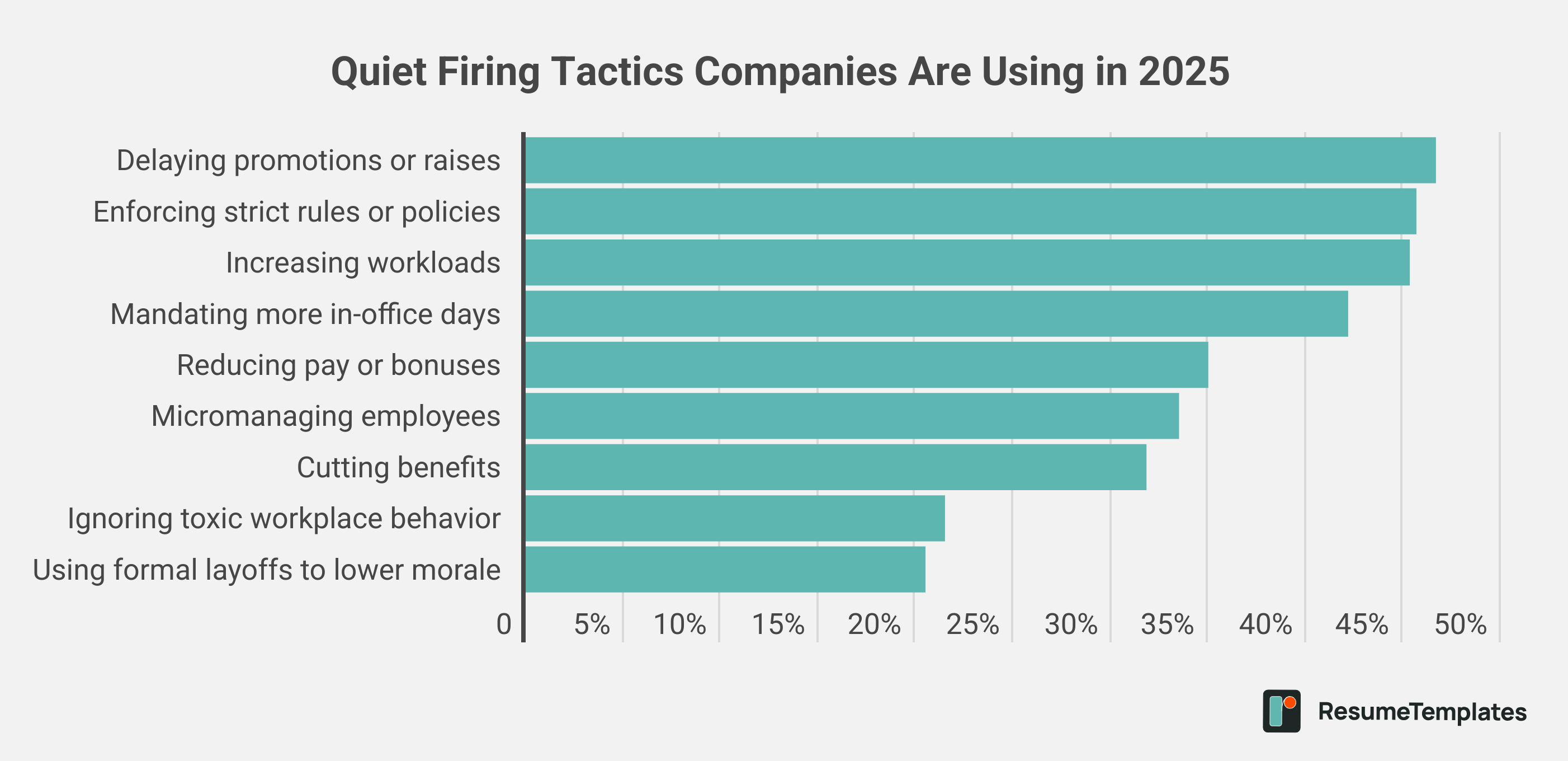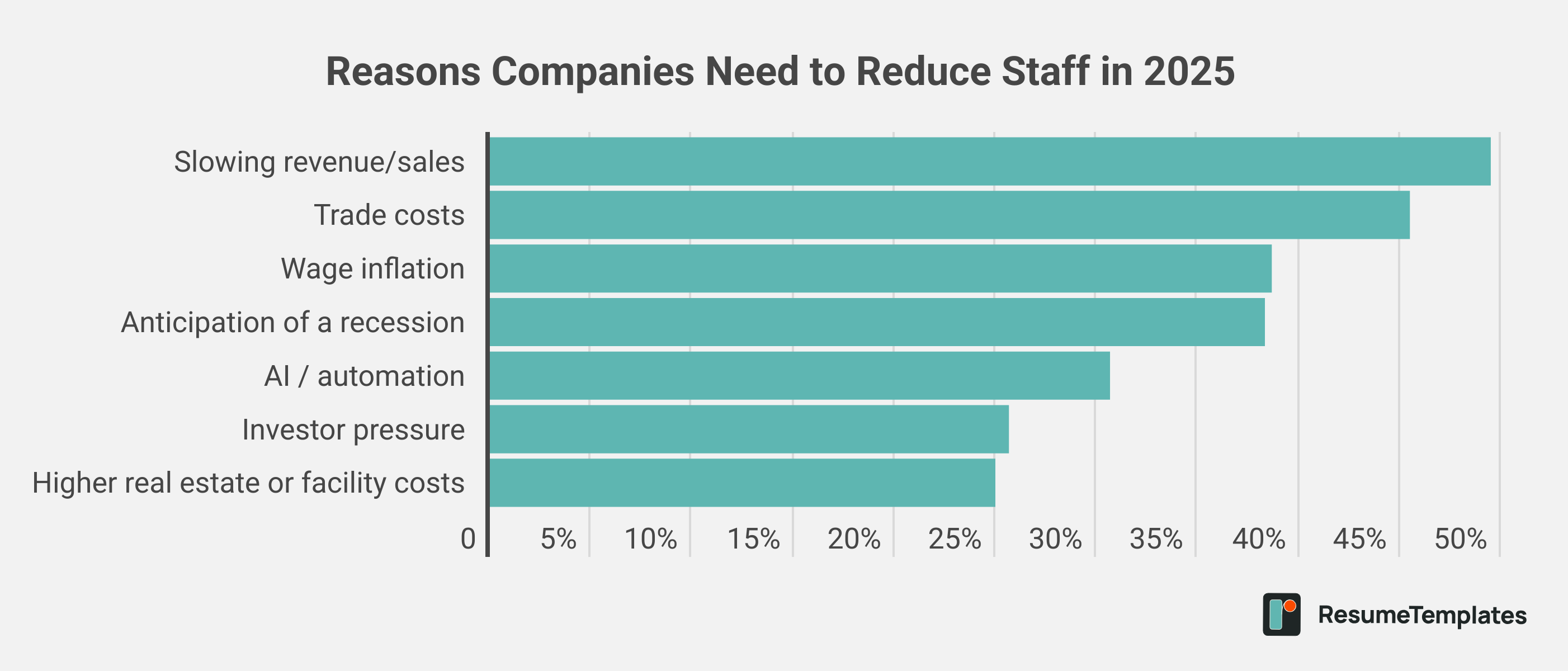A new ResumeTemplates survey of 1,128 business leaders conducted in May 2025 reveals that quiet firing is a widespread workforce strategy this year. More than half of companies say they are either currently using or plan to use quiet firing — defined as pushing employees out through indirect means like benefit cuts, increased workloads, or mandating more office time.
The tactic is often used as an alternative to formal layoffs, allowing companies to trim staff without triggering severance payouts or damaging their public image. While many report it’s effective, most also acknowledge a steep cost to employee morale.
Highlights:
- 53% of companies are quiet firing employees in 2025
- Top tactics include delaying raises (47%), increasing required office days (42%), and cutting benefits (32%)
- 41% say they use quiet firing to push out certain employees, and 32% are doing it to avoid bad press
- Rising costs, including from tariffs, are driving the need for staff reductions
- The majority of companies are also doing formal layoffs
53% of Companies Will Engage in Quiet Firing This Year
More than half (53%) of companies say they are engaging in quiet firing in 2025 — 42% have already started, and another 11% plan to do so later in the year.
Nearly half (47%) say quiet firing helps them more easily manage underperforming employees. Additionally, 41% are quiet firing because they want to push out certain employees, such as those who prefer remote work. Other motivations include avoiding severance payouts (34%), reducing legal risks (34%), and steering clear of bad press associated with formal layoffs (32%).
Tactics include delaying raises, increasing required in-office days, and cutting benefits
To encourage employees to quit voluntarily, 47% of companies say they are delaying promotions or raises. Additionally, 46% will enforce stricter rules or policies, and 45% will increase workloads without additional compensation. About 42% already are or plan to mandate more in-office days, and 35% will reduce pay or bonuses.
Micromanaging employees (34%), cutting benefits (32%), and ignoring toxic workplace behavior (22%) are tactics that will also be used. A smaller percentage also have or plan to conduct formal layoffs to lower morale among remaining staff (21%).

Reduced Revenue and Tariff-Related Costs Drive Reasons for Cutting Staff
The leading reason companies cite for reducing staff is slowing revenue or sales (50%). Tariffs and increased trade costs follow closely at 46%. Roughly 39% anticipate a recession, and 39% cite wage inflation. About 31% say staff reductions are needed due to AI or automation replacing roles, 26% point to pressure from investors, and 25% cite rising real estate or facility costs.
Most companies are making moderate staff reductions in 2025. About 15% are reducing staff by less than 5%. The largest share (40%) say they are cutting between 5% and 10% of their workforce, and another 28% report cuts between 11% and 25%. Roughly 11% say they are cutting 26% to 50% of employees, nearly 5% report cuts of 50% to 75%, and 2% say they are reducing staff by 76% or more.

9 in 10 say it’s reduced morale
Of companies that started quiet firing in 2025, 39% say it has reduced morale a lot, and 46% say it has a little. Only 13% say it’s had a minimal impact on morale, and 2% say it’s had no impact at all.
“From a business perspective, quiet firing can seem like an efficient way to reduce headcount without triggering layoffs, bad press, or severance costs,” says ResumeTemplates’ Chief Career Strategist Julia Toothacre. “But it’s short-sighted. Creating an environment that pushes people to quit inevitably damages morale, productivity, and trust. It can also negatively impact hiring in the future. And let’s be honest, when this tactic is applied broadly, companies risk losing high performers, not just underperformers.”
85% Say Quiet Firing Has Been an Effective Tactic
Despite the costs to morale, most companies that use quiet firing find it effective.
About 27% say it’s been very effective at reducing headcount, while 58% say it’s somewhat effective. Among those who find it ineffective, the top reason is that employees stay because of a tough job market (77%). Additionally, more than half (53%) say workers simply tolerate poor treatment rather than quitting. Other challenges include legal or HR issues (20%) and manager reluctance to fully implement the strategy (13%).
“Many workers will stick it out right now not because they’re engaged, but because the job market feels uncertain. They’re weighing the stress of a toxic workplace against the risk of landing a new job that pays less. This calculator puts employees in survival mode, which will ultimately impact productivity,” says Toothacre.
6 in 10 Have Already Conducted Formal Layoffs in 2025
Quiet firing isn’t replacing layoffs entirely. Nearly 60% of companies say they have already conducted formal layoffs this year.
Looking ahead, 34% say they plan to conduct layoffs regardless of how effective quiet firing is. Another 32% will only lay off employees if quiet firing fails. Eighteen percent say they have no plans for layoffs, while 15% say it depends on other factors.
Methodology: This survey was conducted between May 20 and May 22, 2025. A total of 1,128 U.S. businesses participated. To ensure appropriate responses, participants were required to meet specific demographic criteria.
Resume Templates offers free, HR approved resume templates to help you create a professional resume in minutes. Choose from several template options and even pre-populate a resume from your profile.